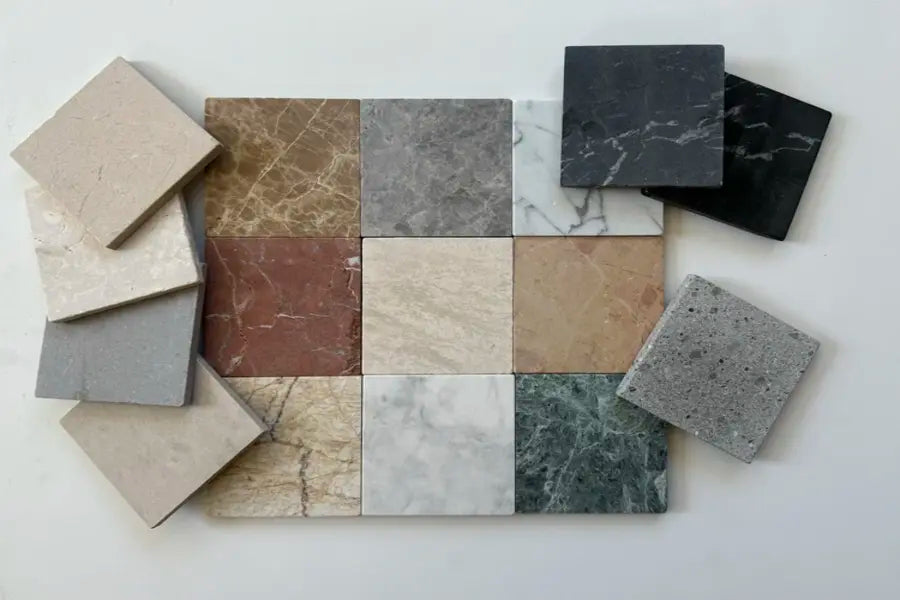Inspired by Nature. Crafted for Design Excellence.
Each slab of natural marble, travertine, or limestone in our collection is hand-selected for its unique veining, color depth, and structural integrity. We partner with trusted quarries to ensure every piece reflects timeless beauty and lasting performance.
Designers and architects love Arda Ogan stone for its:
- Unmatched character: one-of-a-kind markings and textures that elevate design.
- Architectural strength: ideal for heavy-duty floors, walls, countertops, and specialty features.
- Eco-conscious sourcing: responsibly extracted and finished with low-impact methods.
Choosing the Right Stone for Your Project
| Stone | Visual Style | Best Uses |
|---|---|---|
| Marble | Elegant, veined, classic | Bathrooms, feature walls, countertops |
| Travertine | Rustic, porous, textured | Patios, shower floors, indoor-outdoor transitions |
| Limestone | Soft, subtle, warm tones | Living spaces, flooring, backsplash |
Design Trends & Applications
- Bold veins as focal points: use marble with dramatic patterns for statement walls.
- Warm taupes and creams: limestone and travertine balance contemporary and timeless interiors.
- Mixed finishes: polished countertops paired with honed floors for contrasting textures.
Installation & Maintenance Essentials
- Always pre-seal porous stones before installation to prevent staining.
- Clean gently with pH-neutral solutions—avoid vinegar or bleach.
- Apply penetrating sealers every 12–18 months in high-use areas.
- Use protective pads under heavy furniture to prevent scratching.
Ready to Transform Your Design?
Browse our Natural Stone Collection, order a stone sample, or contact our trade team for spec sheets, pricing, and project assistance.
Natural Stone & Tiles — Frequently Asked Questions
How many square feet do I need?
For most projects, we recommend ordering 10–15% extra to account for cuts, trimming, breakage, and future repairs. This ensures color consistency and prevents delays if more material is needed later.
Which materials are best for bathroom and shower walls?
Marble, porcelain, ceramic, limestone, and Zellige are all excellent choices for shower walls when properly installed. Always follow manufacturer recommendations for sealers, setting materials, and waterproofing prior to installation.
Can marble or natural stone be used in showers?
Yes, marble and limestone are widely used in showers. They require:
-
Proper waterproofing
-
A high-quality thinset mortar
-
Neutral-pH cleaners
-
Periodic resealing (if recommended by your installer)
Natural stone ages beautifully when maintained correctly.
Do I need to seal marble, travertine, or limestone?
Most natural stones benefit from sealing, especially in kitchens, showers, and high-traffic areas. Sealers help protect the surface from staining and moisture absorption. Always test a small area first and reapply as recommended by your installer or sealer manufacturer.
What causes color and shade variation in natural stone tiles?
Stone is created by nature, so each tile has its own unique movement, veining, shade, and texture. Variation is normal — and often desired. For the most balanced installation, blend tiles from multiple boxes during layout.
Can natural stone be used on floors?
Marble, travertine, limestone, and onyx can all be used on many interior floors as long as the finish and thickness are suitable. Honed finishes are generally better for floors because they offer more traction and show less wear.
Is natural stone slippery when wet?
Smooth polished stone can become slippery. Honed and textured finishes provide better traction. For wet areas (bathrooms, pool surrounds, entries), choose honed or tumbled finishes for improved slip resistance.
What is the difference between honed and polished finishes?
-
Polished: Shiny, reflective, luxurious appearance.
-
Honed: Smooth but matte, more slip-resistant, and better at hiding etching or wear.
The same stone can look completely different depending on the finish.
How should I clean and care for natural stone tiles?
Use a pH-neutral cleaner designed for stone. Avoid vinegar, bleach, acidic cleaners, or abrasive pads, which can damage the surface.
Basic care includes:
-
Daily wiping of spills
-
Neutral cleaner for routine cleaning
-
Sealer maintenance (if required)
Your installer can recommend a care routine based on your stone and finish.
Can marble and natural stone stain or etch?
Yes, natural stone may etch (dull spots) when exposed to acidic products and can stain if not sealed correctly. Proper sealing, cleaning, and prompt wiping of spills minimize this risk.
Are stone tiles suitable for kitchen backsplashes?
Absolutely. Marble, limestone, and travertine backsplashes create timeless, luxurious kitchens. Just avoid harsh cleaners and reseal the surface periodically.
How long does marble or limestone last?
Natural stone lasts decades or even centuries with proper installation and routine maintenance. Many historic buildings around the world still feature original marble surfaces.
Want help choosing materials?
Our experts can assist with stone selection, layout guidance, care recommendations, and project-specific questions.
Contact us anytime — we’re here to help.


